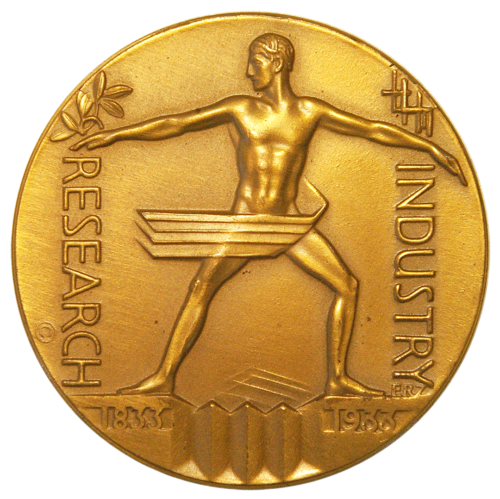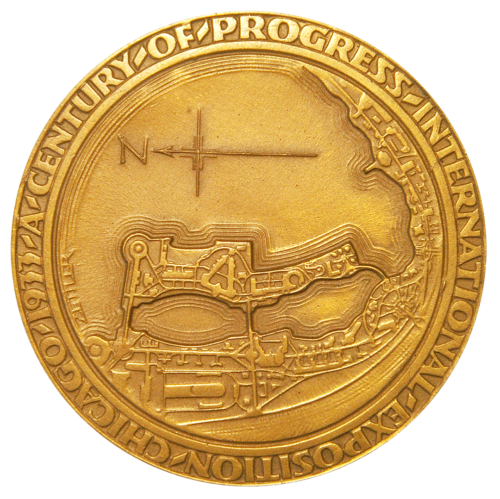M210
Bronze HK463, So Called Dollar (SCD), AU with original box (see Detail 2)
38 mm (1-1/2”)
HISTORY: While during the tough years of the Great Depression (1929–1939), Chicago threw a year-long party to celebrate its centennial anniversary. Planning began in January 1928, when the ‘20s were roaring. A 430-acre, 3-mile stretch of reclaimed land along the Lake Michigan shoreline, between 12th and 39th Streets, was designated for the world’s fair site. It would be known as “A Century of Progress, International Exposition, Chicago, 1933.” The theme was technological innovation with the motto: “Science Finds, Industry Applies, Man Adapts.”
When the fair was conceived, none of its planners could have imagined what life would become just five years into the future. As construction proceeded, it was clear that a happier, more joyful face should be added to the design. Uplifting architecture was encouraged with multicolored buildings and exciting entertainment venues. Before they were household names, young singers (such as the Andrews Sisters and Judy Garland) performed.
The fair officially opened on May 27, 1933, to great fanfare (Detail 1). Exhibitors showed off flashy new automobiles, sleek railroad trains, aerodynamic planes, and modern home designs featuring new building materials. A newly elected president, Franklin D. Roosevelt (1882–1945), visited on October 2nd and gave his two thumbs up, after which the decision was made to extend the popular exposition for an additional year. By its closing on October 31, 1934, the Chicago World‘s Fair had been attended by 48,469,227 visitors.
While many of the exhibitors created their own medals, tokens, and memorabilia, the official medal was designed by Emil Robert Zettler (1878–1946). He received patent “D90, 162” for his design on June 20, 1933. Zettler was an American sculptor who studied, and later taught, at the Art Institute of Chicago. He rose to the head of their School of Industrial Arts. The medal dies were produced by Medallic Art Co., NY, but were actually struck onsite at the Crowe Mint Exhibit (a Chicago metalworking company) using a professional coin press. In 1934, two additional sizes were produced (2-3/4” and 2-1/4”) with “1934 Edition” on the reverse.
OBVERSE: Zettler featured a standing, nude male with flowing loincloth banner, arms outstretched, legs straddling two pillars. Beneath his right foot, “1833”; beneath his left foot, “1933”; beneath his right hand, “RESEARCH,” with a sprig of medicinal herbs above; and beneath his left hand, “INDUSTRY,” with steel scaffolding above. Allegorically, energy is passing through his body from one hand to the other; industry is useless without research. Initials by the designer “ERZ” at his left foot.
REVERSE: An aerial map of the exposition grounds, north and south lagoons, on the shore of Lake Michigan is shown with a prominent north arrow. Interesting also are tracks of the Illinois Central Railroad (IC) running along the bottom and up the right side of the medal. The IC delivered hundreds of thousands of visitors to the fair at its Central Station on 12th Street, just east of Michigan Avenue. The site is now home to Soldier Field football stadium and the Field Museum of Natural History. The north and south lagoons are now large marinas.
Zettler has signed his name to the left side around the inner rim. Encircling the image is “A CENTURY OF PROGRESS INTERNATIONAL EXPOSITION CHICAGO 1933.”



